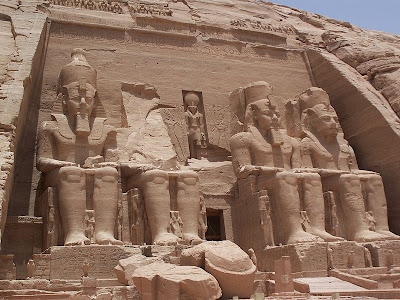Egypt is perhaps best known as the home of the ancient Egyptian civilization, with its temples, hieroglyphs, mummies, and - visible above all - its pyramids. Less well-known is Egypt's medieval heritage, courtesy of Coptic Christianity and Islam - ancient churches, monasteries and mosques punctuate the Egyptian landscape. Egypt stimulates the imagination of western tourists like few other countries and is probably one of the most popular tourist destinations world-wide.
Here is a list of the UNESCO World Heritage Sites in Egypt:
Abu Mena in Alexandria Governorate, Egypt
The church, baptistry, basilicas, public buildings, streets, monasteries, houses and workshops in this early Christian holy city were built over the tomb of the martyr Menas of Alexandria, who died in A.D. 296.
Ancient Thebes with its Necropolis in Luxor Governorate, Egypt

Thebes, the city of the god Amon, was the capital of Egypt during the period of the Middle and New Kingdoms.
Historic Cairo in Cairo Governorate, Egypt

Tucked away amid the modern urban area of Cairo lies one of the world's oldest Islamic cities, with its famous mosques, madrasas, hammams and fountains. Founded in the 10th century, it became the new centre of the Islamic world, reaching its golden age in the 14th century.
Memphis and its Necropolis – the Pyramid Fields from Giza to Dahshur in Giza Governorate, Egypt

The capital of the Old Kingdom of Egypt has some extraordinary funerary monuments, including rock tombs, ornate mastabas, temples and pyramids. In ancient times, the site was considered one of the Seven Wonders of the World.
Nubian Monuments from Abu Simbel to Philae in Aswan Governorate, Egypt

This outstanding archaeological area contains such magnificent monuments as the Temples of Ramses II at Abu Simbel and the Sanctuary of Isis at Philae, which were saved from the rising waters of the Nile thanks to the International Campaign launched by UNESCO, in 1960 to 1980.
Saint Catherine Area in South Sinai Governorate, Egypt

The Orthodox Monastery of St Catherine stands at the foot of Mount Horeb where, the Old Testament records, Moses received the Tablets of the Law. The mountain is known and revered by Muslims as Jebel Musa. The entire area is sacred to three world religions: Christianity, Islam, and Judaism.
Wadi Al-Hitan (Whale Valley) in Faiyum Governorate, Egypt

Located in a desert, the site contains fossil remains of the now extinct Archaeoceti, a suborder of whales, showing the evolution of the whales from a land-based to an aquatic mammal.
Source: Wikipedia
No comments:
Post a Comment